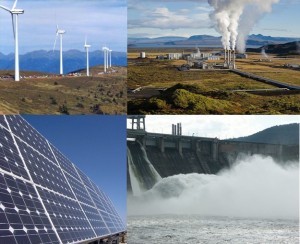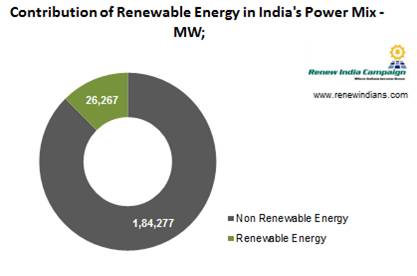Renewable Energy Scenario In India
 Read more on Top Five States in India with Highest Renewable Energy Capacity
Read more on Top Five States in India with Highest Renewable Energy Capacity
A country’s economic progress majorly depends upon its energy resources. Highly developed countries like the USA and China have a high energy consumption rate compared to other developing nations of the world. It has been reported that India’s absolute primary energy consumption is only 1/29th of that of the world, 1/7th of USA and 1/1.6 time of Japan. However, with the increasing danger posed by pollution, there is an urgent need to shun the excessive use of pollution releasing conventional sources of energy and switch over to environment friendly options like the renewable energy resources.
Renewable energy is the energy that comes from replenishable energy sources such as sunlight, wind, etc. There is a large potential for renewable energy in India. It has been estimated that India’s renewable energy production amounts to a total of over 100,000 MW. There is a fully dedicated ministry of New and Renewable Energy, assisted by a number of state nodal agencies that work to enhance India’s position in the area of use of renewable energy sources. The ministry works in coordination with various NGOs and village development societies to outstretch the renewable energy programmes to every corner of the country. Moreover there is a separate agency named Indian Renewable Energy Development Agency Limited (IREDA) which works to provide term loans for various renewable energy projects.
Read more on Top five states in India with highest wind electricity generation
Today India has become one of the world leaders in terms of its extensive renewable energy programmes. Various renewable energy schemes have been introduced that covers different energy resources like the biomass, solar energy, wind energy, hydropower and other emerging technologies. The annual turnover of the Indian renewable energy industry is estimated to be about US $ 10Billion. Much emphasis is being put on to enhance the efficiency of these energy programmes and reduce their investment cost. Power generation using the renewable energy sources has increased by leaps compared to the last decade. India is one of the countries with highest total installed wind power capacity. Wind power alone contributes to a massive 68% of the entire country’s renewable power energy production programme. With the success of the Jawahar Lal Nehru Solar Mission, India today stands as a world leader in the decentralized solar energy projects. There are about 300 clear sunny days in a year in most parts of India. This is equal to over 5,000 trillion kWh/year of the solar power. India also stands second most successful country in terms biogas and improved stove programme. The current availability of biomass in India is estimated at about 120-150 million MT/annum. The India made Biomass Gasifier is now being exported not only to developing countries of Asia and Latin America but also to Europe and USA. The Indian Photo voltaic industry has been growing at an average rate of about 25%. Apart from serving the country’s economic progress the renewable energy programmes have helped a number of rural folks by meeting their cooking and other energy requirements. India has also started to provide technical expertise to other countries for promotion of renewable energy sources.

Of late the Ministry of New And Renewable Energy is working to replace subsidy-driven programmes with commercialization of various technologies. Emphasis has been put on to increase the efficiency of renewable technologies. Concessional taxes and duties, along with soft loans, have been introduced to encourage these enterprises. The central ministry has also directed the states to create an easy and attractive passage for the purchase of renewable energy technologies. Some states are even providing exemption in the state tax in order to promote renewable resources. Financial aid is being provided to educational institutes and industries taking up research projects in the area of renewable energy. Foreign sectors are too allowed to form a joint venture with their Indian counterparts for setting up renewable energy based projects. It has been declared that there would be a deduction in custom and excise duty in the import of renewable energy parts or equipment needed for modernization and renovation of the power plants. There is aprovision to provide infrastructure facilities like roads, rivers, cranes and power for the construction of renewable energy projects.
Indian cities have long started realizing the importance of renewable energy sources and efficient technologies. However, there is still a need to introduce effective implementation of the renewable energy programmes at the village levels. In order to accelerate the development of renewable energy programmes, village panchayats and NGOs should organize awareness raising and training seminars. Workshops conducted by the Thane Municipal Corporation in order to promote the use of solar water heating system are praiseworthy in this regard. The ‘Energy Conservation Building Code 2006’ issued by the government of India provides minimum requirements for energy friendly infrastructure designs. These codes are being extensively used as a criterion for approval of new buildings. Several states have announced guidelines measures pertaining to allotment of land, garbage supply, sale and purchase of power to encourage setting up of waste to energy plants. There has been a growing research on effective implementation of hydrogen and fuel cell technologies. Further the National Geophysical Research Institute, Hyderabad has been involved to conduct study in Satluj-Spiti,Beas and Parbati valley in Himanchal Pradesh and Surajkund in Jharkhand about the effective harnessing of geothermal energy.
India has been ranked fourth most attractive country for investment in renewable energy field by the reputed Ernst and Young magazine. With increasing focus on renewable projects, the renewable energy market is expected to grow significantly. Some of the programmes like the National Solar Mission, National Mission for Enhancement Energy Efficiency, National Mission for Sustainable Habitat, National Water Mission have been widely successful to promote renewable energy technologies in the country. A number of steps are being taken to improve the reliability and quality of renewable energy projects. Renewable energy applications have brought about significant changes in the Indian energy scenario. Apart from power generation programmes, the application of these technologies has significantly helped to reduce the increasing environmental pollution. With the continuing enthusiasm there is no power that can bar India to become the world leader in the area of renewable energy in the coming years.
Author’s Bio;
 Gaurav Pant is from Lucknow (Uttar Pradesh). He has a degree in engineering (B. Tech) in Computer Engineering from G.B.Pant University of Agriculture and Technology, Pantnagar. He can be reached at gauravpant911@gmail.com.
Gaurav Pant is from Lucknow (Uttar Pradesh). He has a degree in engineering (B. Tech) in Computer Engineering from G.B.Pant University of Agriculture and Technology, Pantnagar. He can be reached at gauravpant911@gmail.com.
Do you have a flair for writing? Interested in environmental issues? Why don’t you submit an article for the GreenCleanGuide 2013 contest? For contest rules, please visit this link.



A very nice attempt ! Feels proud to know that India has contributed so much in the area of Renewable energy development ! Proud to be an Indian 1 and congrats to the author..a must win article
Renewable energy use is really the need of the hour…a nice view presented in the essay in a very lucid way… I would like to ask the author what is the current contribution of renewable energy in energy sector in India.
Yes it is the need of the our . we should promote renewable energy sources. it will reduce the global warming effects to extent.
Little to No Global Warming Emissions
Improved Public Health and Environmental Quality
A Vast and Inexhaustible Energy Supply
Jobs and Other Economic Benefits
Stable Energy Prices
A More Reliable and Resilient Energy System
i think renewable energy is can expand the like of out world ……
thank u Gaurav for writing this ..
i think renewable energy can expand the life of the world …*
sorry for typing error